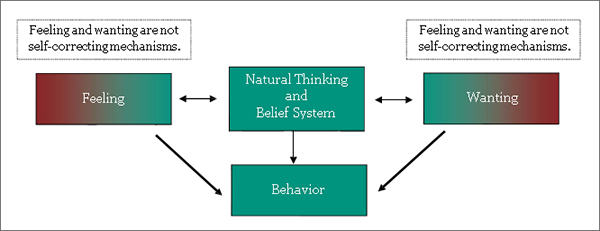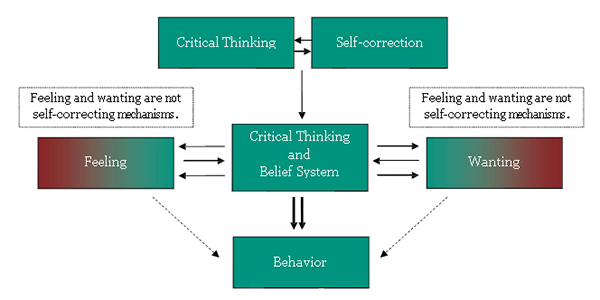This graphic is an attempt to isolate variables that do not exist independently. Thinking, feeling and wanting form a cord of three interwoven strands. Where one exists, the other two are present, continually interacting and influencing one another in a dynamic process.
Adapted from Paul, Dr. Richard; Elder, Dr. Linda. (2002) Critical Thinking. New Jersey: Financial Times Prentice Hall, p. 40-45.
Natural (noncritical) thinking interacts with feeling and wanting in an attempt to keep them in line with our belief system. The interaction, however, may be weak, allowing feeling and wanting to have a more direct influence on our behavior than they should.
Critical thinking is self-correcting. It also amplifies the interaction between thinking, feeling and wanting. Because feeling and wanting are not self-correcting mechanisms, we want greater control over their influence on our behavior, and this happens with the careful examination critical thinking brings.
Note that in the second diagram, the Critical Thinking and Belief System box has much greater influence over feeling, wanting, and behavior (additional and bold arrows). Note also that the influence of feeling and wanting on behavior has been reduced (weak arrows).
Thinking is the key to managing both feeling and wanting—and subsequently—behavior.
We change negative feelings, desires, and habits by changing our thinking.
We change our thinking by changing our belief system.
Test the concept using your own experience.
- Think of a recent situation that resulted in anger, frustration or fear.
- Describe the event thoroughly enough to cover the facts and details of how you felt. [I had merged into a single lane in advance of construction far ahead. The line was barely moving, and I resented the last half-hour I had spent this way. Just as I reach the construction, a driver zooms by in the next lane and forces his way in front of me, nearly clipping my left front bumper as he pulls in. Even though I am hardly moving, I slam on the brakes to avoid hitting him. I am really angry and would rather hit the gas and nail him.]
- Analyze your thinking at the time—the thoughts that led to the negative feeling. Write out the beliefs and assumptions behind your feelings. [I believe it is wrong to cheat or cut in. I believe I have a right to my position because I followed the rules. I believe he is a jerk. I assume he had no emergency that would trump my right to my position. I assume he hadn’t been boxed out earlier, tried to get into the line, and was not let in. I assume there is no other reasonable excuse for his behavior. I assume he understands the normal courtesies of driving.]
- Analyze how your thinking and feeling influenced your behavior. Write out what you were motivated to do based on your thinking and feeling. [Like I said, my feeling and wanting would have rammed him in the rear. But my thinking told me that I would only get in trouble with my insurance company. So I just sat there and fumed.]
- Write out how critical thinking might modify the interchange between thinking and feeling, resulting in a different motivation. [Critical thinking says that my first two beliefs are reasonable, but everything after that is suspicious. I don’t know if he’s a jerk. I don’t know anything about him or his circumstances. It’s possible that I would do the very same thing if I thought the conditions warranted it. Maybe he does have an emergency. In any event, his action hardly delays me any further. It’s definitely not worth raising my blood pressure. I should give him the benefit of the doubt and treat him as I would wish to be treated if I had an emergency—or even if I just made a stupid mistake.]
When you have completed this exercise and seen how your thinking influences your feeling and wanting—and subsequently your behavior—you will appreciate how important your thinking has been. You will appreciate even more how powerful it can be in changing undesirable feelings and desires.
Critical thinking—disciplined thinking—is an important factor in closing the gap between our current reality and our desired reality.
Quality coaching employs critical thinking.


